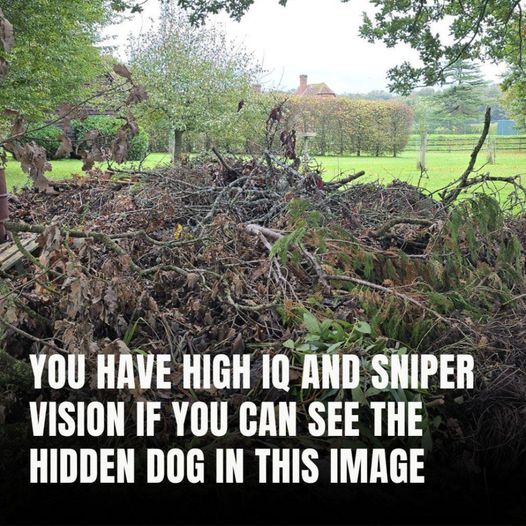Do you think you’re a master of hidden-object puzzles? A viral brain teaser has stumped countless people online—a well-camouflaged spaniel hidden in an image filled with leaves and branches. At first glance, it may look like just a pile of forest debris, but within the chaos lies a dog, hiding in plain sight. Many have tried and failed to find it, sparking a wave of frustration and fascination among puzzle lovers.
Solution is at the end of the article !
 This visual puzzle, created to challenge even the most observant, has left people divided. Some viewers, after careful searching, excitedly spot the dog, while others remain perplexed, convinced it’s a trick. Comments online showcase both sides: “I thought it was a joke until I finally saw it!” and “I had to peek at comments to even believe it was there.” For those who enjoy a visual challenge, the puzzle has become the ultimate test of observation skills.
This visual puzzle, created to challenge even the most observant, has left people divided. Some viewers, after careful searching, excitedly spot the dog, while others remain perplexed, convinced it’s a trick. Comments online showcase both sides: “I thought it was a joke until I finally saw it!” and “I had to peek at comments to even believe it was there.” For those who enjoy a visual challenge, the puzzle has become the ultimate test of observation skills.
Understanding the Appeal of Hidden Object Puzzles
Hidden object puzzles have surged in popularity, thanks to their accessibility and the satisfaction they bring upon finding a concealed detail. They train the brain to focus on subtle differences in pattern, shadow, and form, making them as beneficial as they are entertaining. Puzzle experts note that successful spotting requires slowing down, scanning details methodically, and adjusting visual focus to discern small clues often missed in casual observation.
Tips to Master Hidden-Object Puzzles
To improve your odds of spotting hidden objects, avoid these common pitfalls:
- Looking Only at the Center
It’s natural to focus on the center of an image, but hidden objects are often placed in the corners to evade direct attention. Be thorough and sweep the entire picture, ensuring no section goes unnoticed. - Overlooking Minor Details
When we rush, it’s easy to miss subtle hints. A hidden spaniel, for instance, may blend with its surroundings, so focus on small shadows, edges, or textures that seem out of place. - Doubting Its Existence
Some might quickly conclude that the object isn’t there. Yet, persistence often pays off in such puzzles. Remember, the creator assures the dog is there, cleverly camouflaged. - Skipping Breaks
Staring at an image too long can cause the eyes to glaze over details. A quick break can reset your focus and help you see elements you may have missed before.
Step-by-Step Guide to Spotting the Dog
If you’re still stumped, here’s a guide to improve your chances:

- Begin at the Base: Start from the bottom of the image where natural debris is most dense. Look for unusual patterns or shapes.
- Seek Brown Tones: The dog’s fur blends well with the leaves, but slight variations in shade may reveal its location.
- Observe Curved Forms: The shape of a dog’s head or floppy ears is distinct. Look for rounded outlines that might hint at the dog’s silhouette.
- Focus Near Branches: The dog may be hidden beneath or near a branch, so inspect intersections closely.
- Find the Eye: One of the tell-tale clues is a glint from the dog’s eye, which might stand out as a small dark spot.
This sequence not only aids in finding the spaniel but builds patience and attention to detail, useful in other types of hidden-object games.
Why Puzzles Boost Cognitive Skills
Challenges like these are not only enjoyable but offer genuine benefits for the brain. Studies reveal that visual puzzles sharpen focus, pattern recognition, and patience, enhancing cognitive skills vital for tasks in everyday life. Hidden-object puzzles require mental shifts in perspective, encouraging the brain to search for details it typically overlooks. Regular engagement with puzzles can build problem-solving abilities and improve focus, both valuable in tackling daily tasks efficiently.
 Hidden object puzzles also foster relaxation by shifting the mind from daily worries to a more playful focus. In today’s fast-paced world, taking a moment to immerse in a visual puzzle offers a calming, mindful experience that aids mental well-being.
Hidden object puzzles also foster relaxation by shifting the mind from daily worries to a more playful focus. In today’s fast-paced world, taking a moment to immerse in a visual puzzle offers a calming, mindful experience that aids mental well-being.
Did You Find the Spaniel?
Whether you found the dog or are still searching, remember that visual puzzles like these are meant to challenge and entertain. The satisfaction lies not just in finding the hidden object but in the journey of looking for it. Did you eventually spot the elusive spaniel? If you did, consider your observation skills sharper than most!
Share this puzzle with friends and family to see who spots the dog first. Testing each other’s visual acuity is a fun way to improve attention to detail together.
So, next time you encounter a hidden-object puzzle, remember to stay patient, open-minded, and inspect every corner of the image carefully. With enough practice, you might surprise yourself with improved spotting speed and accuracy.
Happy puzzling!
https://youtu.be/Sik2nQc-zpg
